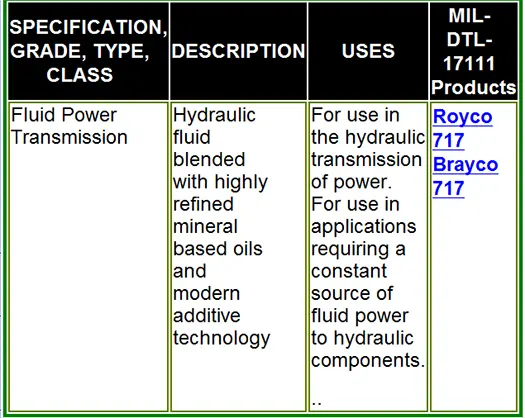 This
hydraulic fluid is blended with highly refined mineral based
oils and modern additive technology to provide protection
against rust, wear, demulsibility, and to afford greatly
improved viscosity - temperature characteristics as well as
enhanced oxidation – corrosion resistance.
This
hydraulic fluid is blended with highly refined mineral based
oils and modern additive technology to provide protection
against rust, wear, demulsibility, and to afford greatly
improved viscosity - temperature characteristics as well as
enhanced oxidation – corrosion resistance.
MIL-DTL-17111C SCOPE:
This specification covers a class of
fluid for use in the hydraulic transmission of power.
MIL-DTL-17111C Intended Use
The fluid covered by this
specification is a medium to be used in connection with
hydraulic transmission power.
MIL-DTL-17111C Subject
term listing
Subject terms listings are Hydraulic mineral
oil, petroleum, and icresyl phosphate.
MIL-DTL-17111C
Materials
The fluid shall consist of mineral oil products
plus 1.0 ± 0.1 weight percent of tricresyl phosphate
conforming to TT-T-656 and approved additive materials for
improving the finished product with respect to the
viscosity-temperature and lubricating characteristics,
resistance to oxidation, and protection of metal parts against
corrosion.
MIL-DTL-17111C Suitability
The fluid
shall be suitable for use in hydraulic systems involving
mechanical or fibrous type filters or centrifugal
purification. It shall be noncorrosive to bearings and
hydraulic systems and shall not cause clogging of oil screens
or valves. The fluid shall remain homogeneous over the
temperature range of -34 °C to 4 °C.
MIL-DTL-17111C Low
temperature turbidity
A dry sample of the fluid shall be
stored at a temperature of 37 °C for not less than 72 hours.
After that time at the storage temperature, the fluid shall
show no evidence of gelling, crystallization, or separation,
and shall develop a turbidity not greater than that exhibited
by a standard suspension of barium sulfate in water.
MIL-DTL-17111C Rust prevention
The transmission fluid shall
prevent the formation of rust.
MIL-DTL-17111C Corrosion
and oxidation stability
The finished fluid must encompass
both resistance to oxidation and protection of metal parts
against corrosion.
MIL-DTL-17111C Packaging
When packaging of materiel is to be performed by DoD or in-house
contractor personnel, these personnel need to contact the
responsible packaging activity to ascertain packaging
requirements. Packaging requirements are maintained by the
inventory control point’s packaging activities within the
military service or defense agency or within the military
service’s system command. Packaging data retrieval is
available from the managing military department’s or defense
agency’s automated packaging files, CD-ROM products, or by
contacting the responsible packaging activity.


MIL-SPEC, military
specification, military standard (MIL-STD) is a United States Defense
standard used to describe a product that meets specific performance and
manufacturing standards for equipment and chemicals.
Other non-defense government
organizations, technical organizations and industry may also use
military specifications are not just limited to The Department of
Defense, as other government organizations and Industry use them as
well.
Here is a Q&A from the Department of
Defense:
What is a performance spec?
A.
A performance specification states requirements in terms of the
required results with criteria for verifying compliance, but
without stating the methods for achieving the required results.
A performance specification defines the functional requirements
for the item, the environment in which it must operate, and
interface and interchangeability characteristics.
Q. What guidance have we given on how to write a performance
specification?
A. Writing performance specifications is not a new concept. We have
been teaching how to write performance requirements for years at
our specification training course. It has received extra
emphasis in our training on how to write Commercial Item
Descriptions. What is new is that we are now designating
documents as "performance specifications."
Q. If you have a performance spec that is MILSPEC, is a waiver needed?
A. No.
Q. Is it possible for a general specification to be designated as
performance and its associated specification sheets to be
designated as detail?
A. No. Since a general specification must be used together with a
specification sheet, the fact that the specification sheet is
detail requires the general specification also to be designated
as detail.
Q. Within the same family of specification sheets, is it possible for some
to be designated as detail and others to be performance?
A. Generally, no. The decision whether to convert a family of
specification sheets to performance specifications must be
consistent across-the-board. In some cases, however, the number
of specification sheets that must be converted to performance
specifications may be very large, making it difficult to convert
all of them at one time. In this situation, there may be a
temporary blend of detail and performance specification sheets
within the same document number series. This situation is
acceptable as long as the goal is to convert all of them to
performance specifications.
Q. Can a performance spec ever cite a detail spec as a requirement?
A. The citing of a detail spec as a requirement does not
automatically mean that a spec is not performance, but it is a
strong indicator that as spec may not be performance.
Performance specs should not cite any detail spec as a
requirement if it demands a specific design solution. But
performance specs may cite a detail spec if it relates to a
physical or operational interface requirement.
For example, it would be permissible to have a requirement in a performance engine
specification that required the engine to operate with specific
substances, such as lubricating oil or fuel, which conform to
detail specs. The requirement that the engine be able to operate
on a specific type of fuel is an operational interface
requirement and does not dictate the specific design of the
engine. However, it would not be permissible in a performance
spec to require the engine be made of certain materials or that
the various engine components conform to detail specs since such
requirements would dictate specific design solutions instead of
stating the performance expected.
Q. I'm writing a spec that describes a "kit."
Should
it be a detail (MIL-DTL-) or a performance (MIL-PRF-)
specification?
A. In general, the answer is that it will likely be a detail
specification; however, there can be exceptions. A spec for a
kit describes a collection of related items, such as adapters,
couplings, bags, tools, attachments, or accessories. A kit may
contain items for installing, testing, or starting up a system
or piece of equipment; it may be provided to equip an existing
system for specific functions; or it may be used to adapt
equipment to meet new or specialized conditions. If the spec
writer were careful to write all of the requirements for the
kit's contents in terms of form, fit, function, and interfaces,
and to cite only performance-type documents, the resulting spec
would support a MIL-PRF designation. As is frequently the case,
however, if one or more of the kit's components are described
using a specific design solution, Technical Data Package, MIL-DTL
type spec, or a non-government standard that contains detail
design requirements, the kit spec must be designated as a MIL-DTL.
The spec writer needs to keep in mind that all of the
requirements for all of the kits' components must be stated in
performance terms in order to produce a MIL-PRF.
 Welcome! Thanks for visiting.
Welcome! Thanks for visiting.
 Welcome! Thanks for visiting.
Welcome! Thanks for visiting.
 Welcome! Thanks for visiting.
Welcome! Thanks for visiting.


